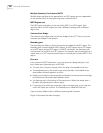
8
STP OPERATION
This chapter covers the following topics:
■ STP Overview
■ Configuring STP
■ MSTP Overview
■ Configuring MSTP
STP Overview Spanning Tree Protocol (STP) is applied in a loop network to block undesirable
redundant paths. Using STP avoids the proliferation and infinite cycling of a packet
in a loop network.
The fundamental feature of STP is that the switches exchange packets called
configuration Bridge Protocol Data Units, or BPDU, to decide the topology of the
network. The configuration BPDU contains the information that ensures that
switches can compute the spanning tree.
The configuration BPDU contains the following information:
■ The root ID consisting of root priority and MAC address
■ The cost of the shortest path to the root
■ A designated switch ID consisting of designated switch priority and MAC
address
■ A designated port ID consisting of port priority and port number
■ The age of the configuration BPDU (MessageAge)
■ The maximum age of the configuration BPDU (MaxAge)
■ A configuration BPDU interval (HelloTime)
■ A forward delay of the port (ForwardDelay)
Configuring STP STP configuration is described in the following sections:
■ Designating Switches and Ports
■ Calculating the STP Algorithm
■ Generating the Configuration BPDU
■ Selecting the Optimum Configuration BPDU
■ Designating the Root Port
■ Configuring the BPDU Forwarding Mechanism


















